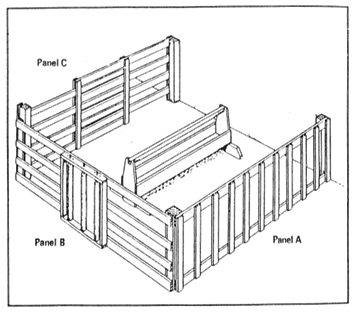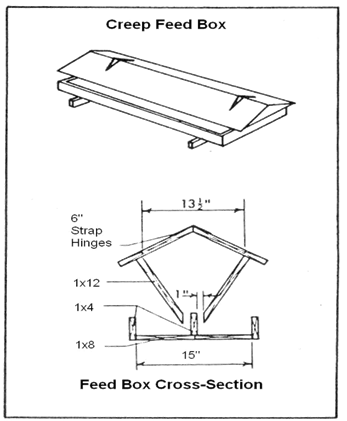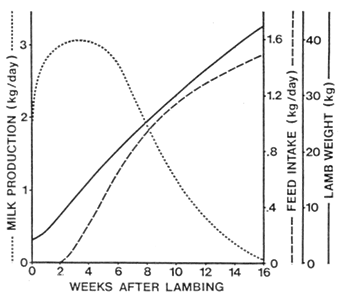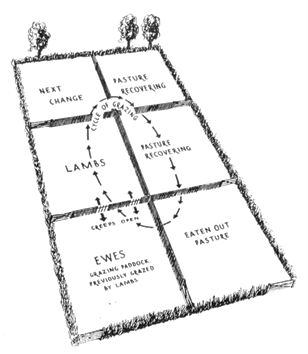.png)
Taking Care of the New Born Lamb
By Basil Bactawar, UF/IFAS Duval County Extension Service

Starting the new born lamb
Starvation is the most common cause of lamb mortality and the level of loss in a flock is strictly related to management. Unless lambs receive colostrum within two or three hours of birth, body energy reserves become critically depleted. Feeding management at this time should include tipping each ewe at lambing (setting a sheep on its rump to trim a sheep's hooves or gain access to its underside is called tipping), checking the udder, removing wax plugs in the teat ends and assisting each lamb with its first meal. This should be followed by careful scrutiny of ewes and lambs two or three times a day and providing nursing assistance until one is confident that each lamb is off to a successful start.
Colostrum should be stored in frozen form in the event that a ewe has insufficient amount to meet the requirements of her lambs. This may be taken from a ewe that has lost her lambs or a ewe that has an obvious excess. Colostrum may also be obtained from goats or cows for emergency use. The best colostrum is obtained from older animals since, having been exposed to more diseases, they will be producing a wider range of antibodies. In addition, the level of antibodies is highest in the first colostrum taken.
Orphan Lambs
The decision to raise a lamb as an orphan should be made within 24 hours of birth since the success of training to a rubber nipple decreases with advancing age. An effective procedure is as follows:
- Allow the designated orphan to remain with its natural mother until the evening of the day of birth making certain that an adequate amount of colostrum has been consumed.
- Late in the evening of the day of birth, isolate the lamb into a small pen (e.g. a claiming pen) preferably with solid walls and, if necessary, a heat lamp.
- Allow the lamb to fast overnight (no more than 8 hours) and in the morning begin training to a round-holed rubber nipple on a bottle containing milk or milk replacer at near body temperature.
- Repeat the training process at two to three hour intervals, allowing the lamb to consume no more than 50-100ml (1.6-3.2 ounces) (depending on size) each time.
- As acceptance of the nipple progresses, the temperature of the milk can be decreased at successive feedings. If the lamb is to continue to be hand-fed, the milk temperature should ultimately reach ambient temperature (50-100 degrees F). If being transferred to a bucket or otherwise self-fed, training should continue until the lamb will readily accept a bottle with a cross-cut nipple containing milk at refrigerator temperature (35-43 degrees F).
In general, small amounts of milk consumed at frequent intervals will yield better results than large volumes fed infrequently. This simulates what occurs naturally when a lamb nurses its mother. The management of orphan self-feeding is most successful when milk (or replacer) is kept cold (35-43 degrees F). When a nipple pail is used, a block of ice in a one liter ice cream pail will keep the temperature down. Low temperature milk causes the lambs to limit their intake at each feeding. Warm milk is often consumed to the point of engorgement resulting in digestive disturbance. When raising orphan lambs, it is particularly valuable to encourage consumption of solid feed as soon as possible. Under intensive management, orphan lambs may be weaned as early as three weeks of age thereby minimizing labor, milk replacer costs and the risks inherent in feeding liquid diets. However, this should not be attempted unless the lambs are vigorous, free of health problems and are consuming creep ration.
Creep Feeding
The practice of encouraging early consumption of solid feed serves to promote development of a functional rumen, increasing the ability of the lamb to utilize nutrients. The primary objective of creep feeding is to provide supplemental nutrients to the lambs during the nursing period to encourage rapid growth. Creep feeding in confinement has little relevance when lambing is timed to coincide with the availability of spring pasture. It is most useful when lambing precedes pasture availability by six weeks or more. In particular, in areas where the grazing season is short, confinement creep feeding can give lambs a significant “head start” on the pasture. A common practice is to lamb in late February or early March, feeding the ewes hay and grain until pasture becomes available. Lambs are either not offered creep or the management of the creep feeding program is such that consumption of creep ration by the lambs is minimal. Ewes and lambs are then put to pasture for the summer. If at the end of the grazing season some of the lambs have not yet reached market size. They are either sold or the extra gain is put on with hay or grain.
Design of the Creep Area
Figure 1 demonstrates several points concerning the design of a creep area. Panel A is the most common design used but it has two inherent faults:
(1) Near the end of the creep feeding period, the oldest male lambs are often wider than those small ewes which have dropped in condition from heavy lactation. It may be impossible to space the pickets to allow these lambs to enter while excluding all of the ewes.
(2) A heavy lamb making a rapid exit from the creep can often knock down one of the pickets, leaving a wide space for the ewes to enter. If there were a significant amount of creep ration in the feeder, grain overload could result.
Placement of a horizontal 1x4, to provide a 12 inch high opening with 10 inch spacing between pickets will improve panel A. The horizontal 1 x 4 will discourage ewes from entering the creep and is easily adjustable in height. If it is placed on the outside of the panel, it will become impossible for lambs to knock down single pickets.
Panel B is a good design but also invites some comment:
- Placement of the three rollers is readily adjustable. While this may seem a strong feature of the design it is not necessary if a single, adjustable horizontal bar is placed across the opening.
- Access to the creep is allowed only through the roller section rather than through the entire length as in Panel A. This is handy, as it allows you to easily catch lambs in the creep by simply blocking this small exit.
- Panel C is a useful innovation which allows expansion of the creep area as the lamb crop grows. A similar panel would replace Panel A. Plan on an allowance of 1.5-2.0 square feet of creep area per lamb.

Figure 1. Components of lamb creep area.

Figure 2. Creep self-feeder
The design of the creep feeder itself should include the following:
- Limited access. Lambs should not be able to put their feet into the feeder. Dirty feed is unattractive to them and fecal contamination spreads diseases such as coccidiosis.
- Sufficient capacity. Although a small quantity of fresh feed twice daily should be put out in the first few weeks, a capacity of at least 1 pound of feed per lamb should be planned for later in the creep feeding period.
Fresh, clean water should be provided in the creep area once the oldest lamb is three weeks of age.
Lamb Psychology
Three factors dominate the behavior of young lambs and a well-designed creep feeding program must recognize them:
- Attachment to the ewe. A young lamb will not stray far from its mother. Once out of eyesight or earshot for any length of time, both ewe and lamb will attempt to re-establish contact. With this in mind, the creep should be placed as close as possible to the area where the ewes bed down. When in the creep, the lambs should be able to see the ewes. Unless these conditions are satisfied, lambs will not be encouraged to enter the creep area.
- Desire for comfort. Once into the creep, lambs will be encouraged to stay if the area is well bedded, warm and bright. If the environment does not dictate the use of a heat lamp, a 40-watt bulb will make the area more attractive at night.
- Curiosity. Lambs are inquisitive and will tend to explore their surroundings as long as it is not at the expense of their security. Curiosity will attract them into the creep and will encourage them to taste the feed offered. This behavior can be reinforced by adding a small amount of fresh feed twice a day for the first few weeks.
Creep Ration
Many differences of opinion exist concerning ingredients and physical form of creep ration. However, the main factors to be considered are nutritional adequacy and palatability. The feeding program should be designed well in advance, and changes which will set back the lambs’ progress should be avoided. The following management practices are recommended:
- As early as possible after lambing begins, set up the creep and put out a very small quantity of soybean meal. It is the most palatable feed commonly available and, although it is expensive, the lambs will consume an insignificant amount. Make sure the meal is always available and always fresh. Do not put out so much that starts to accumulate at the bottom of the feeder. If it does, clean it out daily.
- When the lambs are consuming 30-60 grams (1-2 ounces) per head per day, start adding a 2:1 mixture of wholegrain and 32% protein supplement (containing no urea). In most cases, the lambs will begin to demonstrate a preference for the pellets and grain over a period of 7-10 days. The proportion of soybean meal can be gradually decreased.
- When the lambs reach a weight range of 25-35 pounds change the proportion of whole grain to pellets from 2:1 to 3:1.
- When pasture becomes available, maintain access to the creep area and keep feed available. The lambs will gradually change themselves over to pasture consumption.
Expected Results
If they can be attracted to the creep area, lambs will begin to nibble feed at two weeks of age. At six weeks of age they should be consuming close to a quarter kg (half lb.) per day which is likely increasing their average daily gain by 0.1 kg (.22 lbs.).

Figure 3. The relationship between the potential milk production of a ewe and the growth
and dry feed intake of one of her twin lambs.
By two months of age, the total creep consumption will have reached 10kg (22 lbs.) per lamb resulting in a 5 kg (11 lbs.) “head-start” on pasture or the feedlot. Figure 3 relates consumption of solid feed to lamb growth and the ewe’s milk production.
Creep Feeding on Pasture
When lambing coincides with the beginning of pasture growth in the spring, there is no advantage in encouraging the consumption of concentrates. In fact, early spring pasture is extremely high in nutrient content and lambs tend to prefer this feed over any other. If the flock is confined at night, creep feeding of concentrates may be practiced but usually with little success. If pastures have been allowed to decline in quality the above observations may not apply. Reduced pasture palatability may result in a preference for concentrate.
Forward Creep Grazing
When ewes and lambs are pastured together, lambs are subject to competition from their dams for the most palatable (and highest quality) forage. This tends to discourage forage consumption by the lambs and inhibits productivity. Forward creep grazing is a technique designed to overcome this competition.
When paddock, strip or rotational grazing strategies are used, lambs are allowed access to the next (forward) grazing area before the ewes (fig. 4). This is accomplished by setting up a creep panel between the “present” and the “forward” areas. The practice allows for the separate control of grazing pressures in the two areas. Grazing pressure is the “forward” area should always be light.

Figure 4. Forward creep grazing.
Likewise, in early lactation, grazing pressure in the “present” area should be light to promote milk production. But, as lactation progresses and milk production potential declines, grazing pressure in the “present” area can be increased without penalizing the growth of the lambs. Increased stocking rates in the “present” area will also tend to encourage lambs through the creep panel.
In order for forward creep grazing to be successful, lambs must be trained and much of the same psychology applies here as was described above. The following management practices are recommended:
- Set up the creep panel as early as possible to exploit the lambs’ desire to explore.
- Reduce the size of “present” paddocks as much as possible to increase the lambs’ chances of finding the creep panel. The use of small paddocks will, of course, necessitate more rapid rotations in order to maintain lactation at a high level.
- Place a small, portable feeder in the “forward” area. A spare mineral feeder would be adequate.
- Twice or three times a day put a small amount (e.g. 0.5 kg-1.1 lbs.) of concentrate into the feeder. The act of doing so will stimulate the lambs’ curiosity.
Reference:
Masons, B.D., Bactawar, B. (2010). Nutrition Guide for B.C. Sheep Producers. Revision of the Ministry of Agriculture and Lands, 2004.